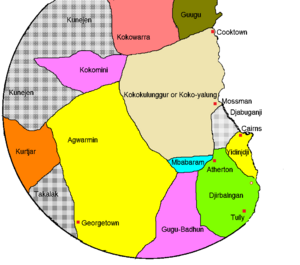Mbabaram language facts for kids
Quick facts for kids Mbabaram |
||||
|---|---|---|---|---|
| Barbaram | ||||
| Region | Queensland | |||
| Ethnicity | Mbabaram | |||
| Extinct | 1979 with the death of Alick Chalk | |||
| Language family |
Pama–Nyungan
|
|||
| AIATSIS | Y115 | |||
|
||||
Mbabaram (also called Barbaram) was an Aboriginal language from northern Queensland, Australia. Sadly, it is now extinct, meaning no one speaks it anymore. The last known speaker, Alick Chalk, passed away in 1979.
Mbabaram was the traditional language of the Mbabaram people. Some of the last known speakers included Albert Bennett, Alick Chalk, Jimmy Taylor, and Mick Burns. Recordings of Albert Bennett and Alick Chalk's voices are kept safe at the Australian Institute of Aboriginal and Torres Strait Islander Studies. A linguist named R. M. W. Dixon wrote about his search for Mbabaram speakers in his book Searching for Aboriginal Languages. Most of what we know about Mbabaram comes from Dixon's research with Albert Bennett.
Contents
What Kind of Language Was Mbabaram?
For a long time, people thought Mbabaram was very different from other Pama–Nyungan languages. These are a large group of Aboriginal languages in Australia. However, R. M. W. Dixon's studies showed that Mbabaram actually came from a more typical Pama–Nyungan form. It changed a lot over time, which made it seem unique.
Even with his research, Dixon still felt that the direct family link between Mbabaram and other languages was not fully proven. Albert Bennett, a speaker of Mbabaram, once said that the Agwamin language felt the most similar to Mbabaram to him.
Where Was Mbabaram Spoken?

The Mbabaram people spoke Mbabaram in Queensland, Australia. Their traditional lands were southwest of the city of Cairns.
Many different Aboriginal tribes lived near the Mbabaram people. They spoke languages like Agwamin, Djangun (part of Kuku-Yalanji), Muluridji (also part of Kuku-Yalanji), Djabugay, Yidiny, Ngadjan (part of Dyirbal), Mamu (part of Dyirbal), Jirrbal (part of Dyirbal), Girramay (part of Dyirbal), and Warungu.
While many of these nearby languages were somewhat understandable to each other, Mbabaram was not. People found Mbabaram very hard to understand. Because of this, Mbabaram speakers often learned the languages of other tribes, but other tribes rarely learned Mbabaram.
Sounds of Mbabaram
Just like English has different sounds (like 'a', 'b', 'c'), Mbabaram had its own set of sounds. These are called vowels and consonants.
Vowel Sounds
Mbabaram had six different vowel sounds.
| Front | Central | Back | |
|---|---|---|---|
| High | i | ɨ | u |
| Low-mid | ɛ | ɔ | |
| Low | a |
Consonant Sounds
Mbabaram also had many consonant sounds.
| Peripheral | Laminal | Apical | ||||
|---|---|---|---|---|---|---|
| Bilabial | Velar | Palatal | Dental | Alveolar | Retroflex | |
| Stop | b | ɡ ɡʷ | ɟ | d̪ | d dʷ | |
| Nasal | m | ŋ | ɲ | n̪ | n nʷ | |
| Lateral | l | |||||
| Rhotic | r | ɻ | ||||
| Semivowel | w | j | ||||
The Funny Story of "Dog"
Mbabaram is famous among language experts for a very interesting coincidence. When linguist R. M. W. Dixon finally met Albert Bennett, he started learning the language by asking for simple words. One of the first words he asked for was "dog."
To Dixon's surprise, Bennett said the Mbabaram word for "dog" was dúg. This sounded almost exactly like the English word "dog"! Dixon thought maybe Bennett hadn't understood his question, or that English had changed Bennett's knowledge of Mbabaram.
But it turned out that dúg really was the Mbabaram word for "dog." This is a complete coincidence, as there is no known connection between the English and Mbabaram languages. For example, other Aboriginal languages have very different words for "dog," like Yidiny gudaga or Dyirbal guda. This story is often used to remind people that just because a few words sound similar in two languages, it doesn't mean the languages are related.
See also
 In Spanish: Idioma mbabaram para niños
In Spanish: Idioma mbabaram para niños

